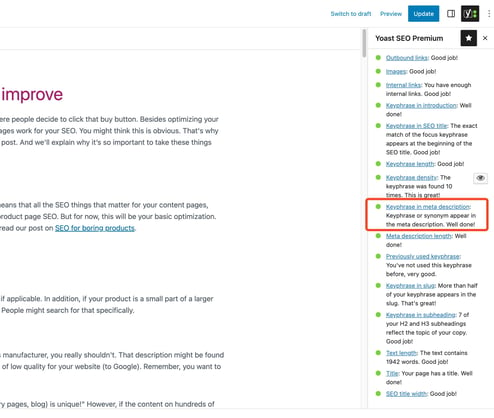How to Write Seo-Optimized Meta Descriptions That Drive Clicks
Do you want more clicks on your website? Start with the meta description.
It’s a small piece of text, but it has a big role. Meta descriptions act like an ad for your page. They appear in search results and help people decide to click. Crafting an effective meta description is both an art and a science.
You need to include keywords while making it appealing. It must be clear, concise, and catchy. A good meta description can improve your click-through rate. This means more visitors and potential customers. In this post, we will show you how to write SEO-optimized meta descriptions that drive clicks. Let’s get started!

Credit: yoast.com
Table of Contents
Importance Of Meta Descriptions
Meta descriptions are often overlooked, yet they play a crucial role in attracting clicks and improving your site’s SEO. Think of them as your website’s elevator pitch. A well-crafted meta description can make a significant difference in your website’s performance.
Role In Seo
Meta descriptions are not a direct ranking factor, but they still matter for SEO. Search engines like Google use them to understand what your page is about. This can influence the relevance of your content in search results.
When you write a clear and concise meta description, you provide valuable context. This helps search engines match your page with relevant queries. The more relevant your page appears, the better your chances of ranking higher.
Impact On Click-through Rates
Have you ever skipped over a search result because the description didn’t catch your eye? That’s the impact of a poorly written meta description. A good one can entice users to click on your link instead of others.
Your meta description should address the user’s search intent. Think about what your audience is looking for. Then, craft a description that promises to meet their needs.
For example, if you’re writing about “healthy smoothie recipes,” your meta description could highlight “Quick and easy smoothie recipes for a healthy lifestyle.” This immediately tells the user what to expect and encourages them to click.
Remember, your meta description is your first impression. Make it count. Use compelling language and a clear call to action.
Have you updated your meta descriptions recently? If not, it might be time to give them a refresh. Small tweaks can lead to significant improvements in your click-through rates.
Crafting Compelling Meta Descriptions
Crafting compelling meta descriptions is crucial for driving clicks. Focus on clear, concise language that highlights key points. Engage readers with a call to action and relevant keywords.
Crafting compelling meta descriptions can significantly boost your website’s click-through rate. A well-crafted meta description not only attracts attention but also persuades users to click on your link. Let’s dive into how you can create meta descriptions that stand out and drive more clicks.
Using Keywords Effectively
Incorporate primary keywords naturally into your meta description. This helps search engines understand your content better and improves your ranking.
For instance, if your article is about “best hiking trails,” include this keyword early in your description. Ensure it sounds natural and not forced.
Avoid keyword stuffing. Overloading your meta description with keywords can make it unreadable and deter potential visitors.
Creating Engaging Copy
Write in a way that addresses the user’s intent and needs. Think about what would make you click on a link.
Use action-oriented language. Phrases like “discover the best hiking trails” or “learn how to write SEO-optimized content” can entice users.
Keep it concise. Aim for 150-160 characters to ensure your entire description shows up in search results. Too long, and it gets cut off; too short, and it might lack detail.
Remember, your meta description is like a mini-ad for your content. Make it compelling, relevant, and informative. What could you say that would make someone choose your link over others?
Best Practices For Meta Descriptions
Crafting effective meta descriptions is essential for improving click-through rates and boosting your website’s visibility. Meta descriptions act as a preview of your content and can be the deciding factor for users choosing your link over others. Adhering to best practices for meta descriptions ensures that your website stands out in search engine results pages (SERPs).
Optimal Length
Keeping your meta descriptions within the optimal length of 150-160 characters is crucial. This ensures your entire description is visible in the SERPs without being cut off. Imagine you are browsing and see a truncated description—it’s frustrating, right?
Concise descriptions are more effective. They quickly convey the value of your content. Use this limited space wisely. Highlight key information and integrate relevant keywords naturally. This practice improves both user experience and SEO.
Avoiding Duplicate Content
Duplicate meta descriptions across multiple pages can harm your SEO efforts. Each page should have a unique meta description. This helps search engines understand the distinct content of each page.
Think about how repetitive content affects user perception. If users see the same description for different pages, it may confuse them or seem untrustworthy. Unique descriptions provide clarity and improve user engagement.
Audit your site for duplicate content regularly. Tools like Google Search Console can help identify issues. Regular updates keep your meta descriptions fresh and relevant.
Are your meta descriptions driving clicks? Consistently applying these best practices can make a significant difference. Try it and see the improvement in your click-through rates!
Analyzing And Improving Meta Descriptions
Analyzing and improving meta descriptions is crucial for better SEO performance. Meta descriptions affect how search engines display your page. They also influence users’ decisions to click. So, your meta descriptions must be clear and compelling. Here’s how you can use analytics tools and A/B testing to refine them.
Using Analytics Tools
Analytics tools help you see which meta descriptions perform well. Google Analytics and other tools provide this data. Check the click-through rates (CTR) of your pages. High CTRs mean your meta descriptions are doing well. Low CTRs suggest room for improvement. Look at pages with low CTRs. Analyze their meta descriptions. Are they engaging? Do they match the content on the page?
Tools like Google Search Console can also help. They show which keywords lead to your pages. Ensure your meta descriptions include these keywords. This alignment can improve your search rankings. It also helps users understand what your page is about.
Conducting A/b Testing
A/B testing is a method to compare two versions of a meta description. Create two different descriptions for the same page. Monitor which version gets more clicks. This helps you understand what works best. Maybe one version is shorter. The other might use stronger action words.
Run these tests for a set period. Analyze the results. Choose the better-performing description. This process can be repeated to keep improving. Testing helps you find the most effective language. It ensures your meta descriptions attract more clicks.

Credit: yoast.com
Conclusion
Crafting seo-optimized meta descriptions can boost your click-through rates. Keep descriptions clear and concise. Use targeted keywords naturally. Engage readers with a call to action. Regularly review and update your meta descriptions. This ensures they stay relevant. Follow these tips for better visibility.
Happy writing!

